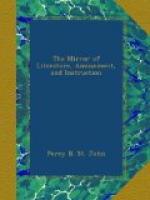were ordinary posts against which they piled billets
and bavens: in this place they had their
ovens, in that a bolting place, in that their kneading
trough, in another (I have heard) a hogs-trough; for
the words that were given mee were these, this
place have I knowne a hog-stie, in another a store
house, to store up their hoorded meal; and in
all of it something of this sordid kind and condition.
It was first let by the corporation afore named, to
one Wyat, after him, to one Peacocke,
after him, to one Cleybrooke, and last,
to one Wilson, all bakers, and this chappell
still imployed in the way of their trade, a bake-house,
though some part of this bake-house was some time
turned into a starch-house.
“The time of the continuance of it in this kind, from the first letting of it to Wyat, to the restoring of it again to the church, was threescore and some odde yeeres, in the yeere of our Lord God 1624, for in this yeere the ruines and blasted estate, that the old corporation sold it to, were by the corporation of this time, repaired, renewed, well, and very worthily beautified: the charge of it for that yeere, with many things done to it since, arising to two hundred pounds.
“This, as all the former
repairs, being the sole cost and charge
of the parishioners.”
[4] By M.M. Concanen, jun. and A. Morgan.
A correspondent, E.E. inquires how it happens that the Chapel of St. Mary Magdalen, shown in all old plans of the Church, has likewise disappeared within the present century? This Chapel adjoined the South transept, and was removed during the repairs, under the able superintendence of Mr. Gwilt. It was thus described by Mr. Nightingale in 1818:
“The chapel itself is a very plain erection. It is entered on the south, through a large pair of folding doors, leading down a small flight of steps. The ceiling has nothing peculiar in its character; nor are the four pillars supporting the roof, and the unequal arches leading into the south aisle, in the least calculated to convey any idea of grandeur, or feeling of veneration. These arches have been cut through in a very clumsy manner, so that scarcely any vestige of the ancient church of St. Mary Magdalen now remains. A small doorway and windows, however, are still visible at the east end of this chapel; the west end formerly opened into the south transept; but that also is now walled up, except a part, which leads to the gallery there. There are in different parts niches which once held the holy water, by which the pious devotees of former ages sprinkled their foreheads on their entrance before the altar, I am not aware that any other remains of the old church are now visible in this chapel. Passing through the eastern end of the south aisle, a pair of gates leads into the Virgin Mary’s Chapel.”
From what we remember of the character of this Chapel,




